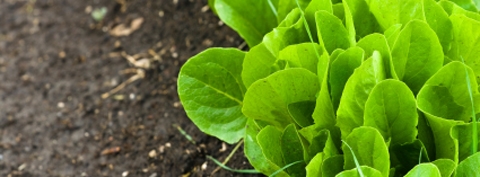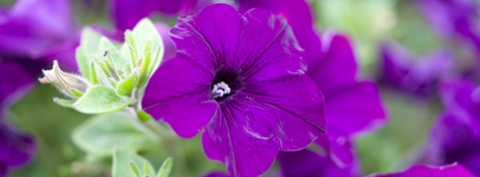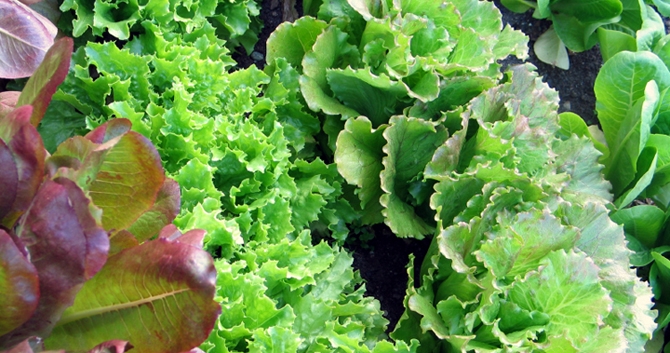There’s nothing like a salad to make a healthy meal, and nothing like lettuce picked right from the garden to make an irresistible salad! Even devoted fans of salad dressing might be tempted to have it on the side after tasting home grown lettuce.
Simple to grow and taking up very little space, lettuce great for small spaces, containers, window boxes, and vertical gardens. It’s also ideal for tucking between larger plants, taking full advantage of every inch of garden space. With pretty ruffled leaves in shades ranging from pale to deep green, russet and mauve, lettuce even has a place in the flower garden as an accent plant.
 Lettuce fresh from the garden makes a salad irresistible
Lettuce fresh from the garden makes a salad irresistible
First appearing in the Mediterranean over 4,000 ago, lettuce has become synonymous with salad, creating the foundation upon which all other ingredients are added. It’s one of the trinity in the iconic BLT and appears as a topper in countless other sandwich riffs – even nudging the bread aside as a healthy alternative that holds everything together.
Lettuce belongs to the Compositae family, which also includes daisies, sunflowers, artichokes, marigolds, chrysanthemums, dahlias, and zinnias. After centuries of cultivation there’s now a wide range of lettuce varieties available with unique flavors, textures and colors. The most popular varieties fall into four categories; crisphead, butterhead, loose-leaf, and romaine.
Crisphead
 Iceberg lettuce is the most widely known of the crisphead varieties
Iceberg lettuce is the most widely known of the crisphead varieties
Iceberg lettuce is the most widely known of the crisphead varieties. Crisphead lettuces are generally valued for their crunchy texture, and their mild flavor serves as a backdrop for other salad ingredients. They have tight heads with firm, crisp, pale green leaves. Crisphead lettuces need a long, cool growing season and are best harvested in early summer or fall.
Summer Crisp varieties are available that are fairly resistant to heat. These are pleasantly sweet, with loose heads similar to Butterheads and the crunch of Romaine without the bitterness. Look for varieties like Batavia, Batavian, Cherokee, Barbados, Nevada, Anuenue, or Magenta.
Butterhead
Butterhead lettuces such as bibb and Boston lettuce are prized for their buttery soft texture and sweet, subtle flavor. Their large, tender outer leaves in shades of green, red, and bronze are ideal for salads, pairing especially well with delicate dressings. Their pale inner leaves, shielded from the sun while growing, are considered a delicacy. Butterheads are one of the easiest lettuces to grow and can be planted from spring through fall. Popular varieties include Buttercrunch, Cassandra, Fatima, Tom Thumb, Ermosa, and Sangria.
Loose-leaf
Nearly every garden has at least one row of loose-leaf lettuce – compact and easy to grow, it can be harvested throughout the season. With a sweet delicate flavor and frilled, ruffled, or lobed leaves, it elevates any sandwich or salad. Instead of forming heads, loose-leaf lettuces grow in compact bunches of tender leaves joined at the stem. Varieties include green-leaf, red-leaf, and oak-leaf, which range in color from dark green and bronze to burgundy and purple.
Romaine
Romaine lettuce, also known as Cos lettuce, has long, crisp dark green leaves, firm juicy ribs, and a sharp slightly bitter bite. Named for the city of Rome and the Greek island of Cos, it is widely known as the lettuce used in Caesar salad, holding its own alongside the robust flavors of Parmesan and anchovies. Romaine also pairs well with light vinaigrettes and assertive vegetables like radishes and asparagus. Plants are fairly heat tolerant, thriving even in summer when other lettuces are wilting. Popular varieties include Little Gem, Winter Density, Bubbles, Lobjoits Green, Valmaine, and Green Towers.
Getting Started
 Lettuce prefers rich soil high in organic matter that holds moisture but drains freely
Lettuce prefers rich soil high in organic matter that holds moisture but drains freely
Lettuce prefers rich soil high in organic matter that holds moisture but drains freely. It grows best in full sun but appreciates afternoon shade when the weather heats up. When selecting a location, avoid sites that tend to be hot and dry.
Prepare the site by removing debris, loosening the soil, and breaking up any clumps that are larger than an apple. Add compost or other organic garden mix to provide nutrients for healthy growth. Composted manure, blood meal or cottonseed meal will provide extra nitrogen for healthy leaves.
Care Tips
Lettuce is a cool weather crop that grows best when temperatures are between 45 and 80 degrees. It thrives in the spring and fall, but will also grow during summer months if shielded from the hot afternoon sun. Plant lettuce in the spring, about a month before the last frost, or in late summer so plants mature in the fall when the weather is cooler.
Planting:
Space plants according to their mature size, leaving room to walk between rows. Loose-leaf lettuces can be spaced more closely together if you plan on continually harvesting them. Stagger plantings every 10 to 14 days so you’ll have an ongoing harvest throughout the season.
Watering:
Lettuce has shallow roots and needs frequent light watering, preferably every morning.
 Lettuce is a cool weather crop that thrives in the spring and fall
Lettuce is a cool weather crop that thrives in the spring and fall
Mulching:
Mulching is essential for retaining moisture, especially in warmer weather.
Fertilizing:
Nitrogen is essential for growing tender new leaves, so feed regularly throughout the growing season with a fertilizer formulated for vegetables.
Harvesting
Generally, Romaine and crispheads are harvested only once when the heads are fully mature. Other lettuces may be harvested whenever they are large enough to use, either by picking a few leaves from the outside of the plant and leaving the central bud to grow more leaves, or by cutting the entire plant at the base.
The best time to pick lettuce is in the morning after the leaves have swollen with water overnight. Later in the day, the sun and heat will cause leaves to lose some water and possibly begin to wilt.
Companion Plants
Take advantage of plants that grow well with lettuce, deterring pests, improving taste, and beautifying the garden. The following plants are good companions:
- Onions, leeks, chives and garlic increase disease resistance and deter pests. They also grow upright and don’t compete for space.
- Chervil promotes growth and improves flavor.
- Aromatic herbs like sage, mint, and lemon balm repel pests.
- Anise, lovage, and borage increase disease resistance.
- Marigold, geranium, petunia and nasturtium deter pests both above and below ground.
 Petunias deter pests both above and below ground
Petunias deter pests both above and below ground
Several edibles make good neighbors by helping to improve growing conditions. Take full advantage of these plant combinations to improve health and vigor:
- Broccoli, radishes, beans, carrots, and beets provide shade for sensitive lettuce.
- Cucumbers grow and mature in the summer after spring lettuce has been harvested.
- Dill provides needed shade and attracts beneficial insects.
Conversely, steer clear of planting cabbage, parsley, or celery near lettuce, as these will all attract pests and interfere with growth and flavor.
Troubleshooting
Bolting: As lettuce matures and the weather warms up, flowers and seed stalks begin to form. This generally signals the end of those plants productive life, and it’s best to harvest and use the lettuce immediately or store in the refrigerator.
Bitterness: Lettuce may become bitter during hot weather or when plants begin to bolt. To mellow the flavor, wash and store the leaves in the refrigerator for a day or two. If the flavor has intensified to the point of becoming unpalatable, simply uproot and start again later in the season.








